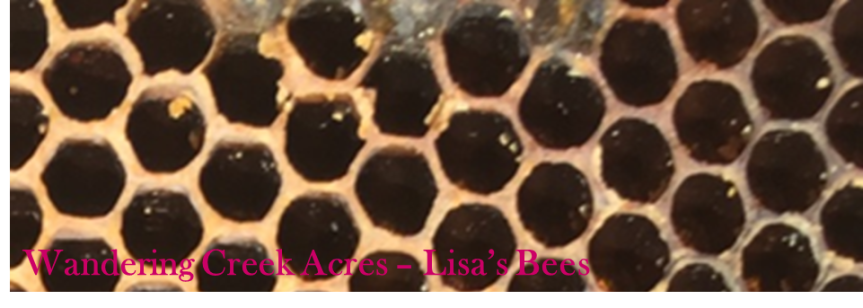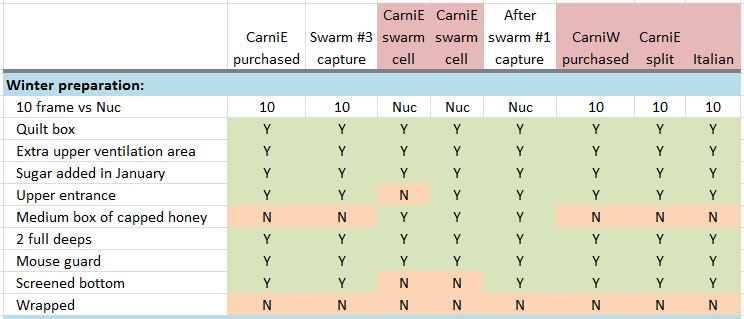Before you begin an autopsy, you first need to determine what to look for. The things that I look for are:
- Size of the cluster when it died
- Evidence of moisture in the hive
- Evidence of Varroa mites
- Evidence of Varroa feces in the cells
- Evidence of Dysentery
- Evidence of deformed wing virus
- The amount of honey stores remaining
- Evidence of pests living in the hive

Snow in the hive

No more honey?

Varroa mites

Dysentery

Too small to survive

Lots and lots of dead bees
Q1: What is the size of the cluster when it died?
As winter continues, the colony within a hive naturally declines in size. The smaller the colony gets, the more difficult it gets for the colony to keep warm, sometimes reaching the point that it can no longer survive.
In the pictures below, the clusters are too small to survive a cold spell.
Q2: Is there evidence of moisture in the hive?
Moisture in the hive causes bees to become chilled during the winter and chilled bees die. Moisture in the hive can be caused by 1) the bees themselves, they are living creatures that generate heat and this warm moist air in the hive hits the top and condenses, raining water upon the bees. 2) water pooling up at the bottom, keeping the hive damp, and 3) snow and rain entering the hives.
In these pictures you can see that water has pooled in the bottom tray, that there is snow in with the dead bees and that the wax cappings have started to mold. All evidence that there is moisture in the hive and probably was throughout the winter.

Water in tray

Mold on cappings on bottom board

Snow in the hive
Q3: Is there evidence of Varroa mites?
Excessive amounts of Varroa mites on the bottom board means that your bees had excessive amounts of mites on them. This would have weaken the bees and throughout the winter they sicken and die.
The brown specs in the first picture are the varroa mites that have fallen off the bees. In 2 of the pictures, I magnified the picture and then circled every varroa mite that I found. The bottom picture is a close up of varroa, unfortunately a little blurry.
Q4: Is there evidence of Varroa feces in the cells
If you are unable to inspect the fallout of your hive, you can look within the empty cells to see if there is varroa feces lining the walls. This will appear as white specs on the insides of the cells.

Q5: Is there evidence of dysentery?
Dysentery is a sign that the bees are sick. During the winter months bees hold all waste within their bodies, they do not defecate within the hive. On a warm day, when the bees are able to take flight, they will leave the hive to relieve themselves and then return before they become too chilled. When they have dysentery it is evident through brown streaks and spots on the hive and snow.
Dysentery is a sign of a virus passed on from the Varroa mite. This virus makes the bees weak and die.
Q6: Are the bee’s wings deformed?
Deformed wings are caused by a virus that is transmitted to the honeybee by the Varroa mite.
I do not have a picture of this since I’ve only seen this one time during my first year as a beekeeper. Here’s a few pictures of what healthy wings on bees look like:
Q7: How much honey remains?
A warmer than normal winter can cause bees to go through their honey stores quicker than the beekeeper plans. Also, cold can cause the tight cluster to be unable to move to reach more honey stores.
During inspection of the honey stores, I also take note of where the final cluster was found in relation to these stores. The 2 frames that are stacked on top of each other, were position in the hive in this way, one on top of the other. As you can see the small cluster was just below a frame of honey, but there was a small gap between the bees and the honey. The bees did not realize there was honey above. The picture on the right and the bottom shows that the bees had made it to the top of the honey stores, even placing a sugar block above them didn’t help them survive.
Q8: Did pests take up residence and eat the honey and bees?
Mice is the one pest that I worry about entering my hives in the fall and then living off of the bees and honey frames during the winter. I do not have pictures of this, since I’ve never had mice in my hives. I take care to add a mouse guard in the fall to keep them out.
Autopsy conclusion:
Once I have determined the answered for the questions above and take into account the state of the colony/hive when it entered winter, only then can I determine which of the following may have caused the demise of the hive:
- Starved bees….. lack of winter stores due to being too cold to move around OR too mild of a winter and the bees ran out of stores.
- Moisture in the hive.. may have caused the bees to die.
- Varroa mites… possibly sickening and weakening the bees.
- Pests…. eating the bees honey stores and causing a decline in bees.
- Fall colony too small to survive winter.
What’s Next:
Using this information I can create a plan for the fall, which will hopefully give my colonies a better chance of surviving this coming winter.
I hope this helps you with your hive autopsies. Over the next few weeks I will post the autopsies from 5 of my dead outs and finish with a post detailing my plan for winterizing my hives this coming fall.
Would love to hear how your bees did this winter… please share.
~ May all your wandering take you to many wonderful places!
Come join me on facebook.





























